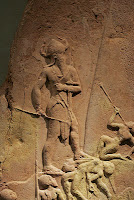The Sanctuary.
A short film of me being confused by The Sanctuary. I wondered if the place people chose as the grave of the fifteen year old buried by the side of a Sarcen, was correct or not?
I don't believe the place they have chosen is correct; the right place is marked by a buried Sarcen in front of one of the concrete posts on the right, in the first ring of stones.
But that matter's not. The reason why there is a tendency to assign female gender to burials that look like sacrifices may have less to do with scientific data, and more to do with mythology, and mainly I would say because of the Persephone myth.
I have absolutely no doubt at all that by the time of Woodhenge, femaleness was still linked to fertility -in other words I think that the first theory hunting communities come up with is that the spirits of dead animals must return to the world, and that it is a female spirit who re-births them.
This Mistress of the Animals becomes Persephone very late on (in terms of civilisation).
The abduction of Persephone in the Greek tale is a more recent version of the abduction of Ereshkigal, chronologically speaking, and the Persephone myth is dealing with more human forces and experiences than those in the Erishkigal tale. The Persephone myth expresses marriage as a symbolic death; it also expresses the reality that women were treated as property. The Greeks considered the abduction of a king's daughter as a just cause of war. Paradoxically in the Persephone story the power of Demeter is shown as a greater force than any army...and yet...not enough to restore her daughter to the upper world; in contrast to Menelaus restoring Helen.
These themes are woven through the Greek myth and reflect their society.
How much do I rate the connection between Demeter, pigs and Durrington? Well the pigs are linked to Demeter via the Persephone myth, but I see this Greek layer of understanding as younger than the original myth. Pigs and 'Earth Mothers' have an older and deeper connection than that of Eubuleus losing his pigs down a chasm broken open as Hades descends to the underworld with the wretched and tearful Persephone clinging to the chariot for dear life.
But then...Eubuleus which could be translated as 'The good clod (of earth)' sounds suspiciously like Euboulos 'the good councillor' and Euboulos was the original he who cannot be named. In other words, the Lord of the Underworld. So at this point the pigs and the throwing down the chasms of pigs (Thesmophoria) starts to get confusing.
I haven't read the latest Micheal Dames book, but I rather liked his first one.
I think I may be annoyed if he takes the Persephone myth too literally, though? I mean the Persephone myth is the Greek version of a Sumerian myth which no doubt goes back and back and back...The Mistress of the Animals may have been Joseph Campbell's invention, but he did provide evidence for it.
I liked Micheal Dames' version of Silbury as a massive, pregnant belly, but I'm not having it that the Durrington midwinter pig festival had anything in common with the Thesmophoria, there simply isn't evidence for that, but plenty to the contrary.
And as I say, the connection between pigs and The Earth Mother is something much older than Persephone.
Anyway...yes...the Thesmophoria and the pigs getting thrown down pits and Durrington. The way archeological evidence tells it, pigs seem to represent the living whilst cattle are the sacrifice of choice for the dead. In the Thesmophoria and before the Eleusinian mysteries the pig stood as a symbol for human sacrifice. Also in purification rites to absolve a person of murder (see The Orestia) a pig is sacrificed to pay back the blood. In the long barrows and in the latter starbursts, Stonehenge and round barrows cattle are the sacrifice of choice. In the Greek rituals the pig in some way represented Persephone as the force that restores life from death. The pigs at the Thesmophoria were thrown down the chasm (I think that idea comes from one of Aristophanes' plays) and there is some evidence for this having happened, but not much. The remains from the previous year's pigs were brought up by women known as 'bailers' who placed the rotted things on the shrine before sending them to be ploughed into the ground to increase the growing power of the land (today we use blood, fish and bone...bought in a plastic bag).
I don't think that pigs were used specifically in that way in Britain...
And then there is the link between pigs - again from Aristophanes mystery piggies- firtility, Persephone, celebacy and sex.
So much, so much to sort out :)

